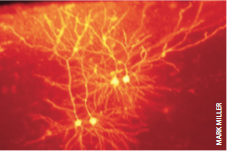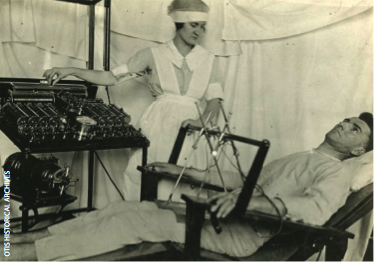SATURDAY, 11 OCTOBER 2014
Michael levin’s research group at Tufts University can make tadpoles grow eyes in their gut. This might sound like a bizarre drug side effect, but the reality is simpler – and more profound. All that the researchers in Levin’s group did was alter the electrical properties of gut precursor cells. Such cells were previously thought to only develop into the gut, and to be unable to form other tissues. Amazingly though, the ‘electrified’ gut cells proceeded to develop into eyes unaided. Levin’s results are the first conclusive proof that electrical signals can be a master control switch in organ formation. They have also stimulated renewed interest in the use of electricity to treat disease.The idea that electricity is fundamental to life and health has haunted the scientific and popular imagination since at least the 18th century. The story of bioelectricity, as we now call it, began with an Italian physician, Galvani. He discovered that the legs of a dissected frog would kick as though alive when an electrical spark was applied. From the 19th century onwards, electrotherapeutic devices were widespread in Western countries, and are still used in the beauty industry, though not th always regulated or scientifically justified. The 19 century also produced one of the most memorable occurrences of bioelectricity in fiction: the scientist Frankenstein, who galvanised his creature into life using an electric current.
So what is bioelectricity, exactly? We now know that all the cells in our bodies have a voltage, or difference in charge, across their outer membranes,in other words, cells are tiny batteries. The voltage is called the ‘membrane potential’ and it is generated from differing concentrations of ions inside and outside the cell, usually sodium, potassium and chloride. Only living cells have a membrane potential: when a cell dies, the difference in charge promptly collapses, showing that electricity really is a crucial part of life!
The membrane potential has two main functions: to set cell identity and to help cells communicate. Cells within a tissue or organ have a specific value for their membrane potential. For instance, in Levin’s tadpoles the membrane potential of eye precursor cells is normally greater than in gut precursor cells. The gut precursor cells could only form eyes when their membrane potential was artificially increased to an ‘eye-like’ level. The most powerful example of cell communication is our nervous system, which transmits information around the body using electrical impulses. These signals are in fact rapid and transient changes in the membrane potential that propagate down our nerve cells to their targets.
Given bioelectricity’s importance in the nervous system, it’s not surprising that its first therapeutic use in modern medicine began with the brain. Some initial approaches, particularly early electro- convulsive therapy (ECT), were crude. ECT was used to treat psychological disorders. It involved passing an electric current across the hemispheres of the brain. It is now just as much a part of the literary imagination as Frankenstein and his galvanism. The experiences of ECT patients in the early to mid-20th century have inspired several novels (think The Bell Jar, and of course, One Flew over the Cuckoo’s Nest).
Despite their grim past, therapeutic approaches like ECT are still used today. ECT is now done under anaesthetic, using small and carefully controlled electrical currents. For many patients with severe depression which does not respond
to drugs it is the only treatment that works. Similarly, deep brain stimulation is a treatment which delivers electrical pulses to a specific brain area through an electrode. It is one of the only treatment options for Parkinson’s disease patients whose symptoms do not respond to drugs.
We are beginning to understand how a simple electric current can have such dramatic effects on our health–from re-setting a person’s mood to stopping muscle tremors–many cells switch genes on or off in response to electrical signals. Still, the interaction between gene activity and bioelectricity is complex and often unpredictable, we are a long way from a complete understanding. Since bioelectricity interacts with basic cellular functions like gene expression, it is important for maintaining all the body’s systems–not just the brain and nervous system. As the biomedical community has started to accept this idea, therapeutic applications for bioelectricity have increased. Electricity has been used to treat rheumatoid arthritis, a painful condition where the immune cells that normally protect us from infection are overactive and attack healthy tissue –in this case, the limb joints. The disease can be practically reversed by electrical stimulation of the vagus nerve. This might seem strange given that this nerve sends signals to internal organs like the gut and spleen. However, the spleen is also one of the training centres for immune cells,and is responsible for priming immune cells to attack specific targets. It is thought that slight changes in the electrical signal carried by the vagus nerve were enough to help the rheumatoid patients’ spleens function normally again. This experimental treatment was so successful that it generated a start-up company, SetPoint, and has progressed to an equally successful clinical trial.
Bioelectricity has even been implicated in cancer and regenerative medicine. Researchers are finding that the membrane potential in cancer cells is abnormal. This is generating interest in ‘electroceuticals’: prospective drugs and diagnostics that target the electrical properties of cancer cells. Dyes to mark changes in membrane potential within living tissues are already available for laboratory use, and indeed were used in Levin’s ground-breaking tadpole experiments. Similar techniques could be developed to visualise tumours in cancer patients. Other work, again in tadpoles, has shown that we can control limb regeneration just by manipulating or blocking specific electrical currents. Perhaps in the future, electrical stimulation could be used to build simple tissues or organs in culture for transplant patients.
The story of bioelectricity has traced a long and colourful path through history, science and literature. Levin’s tadpoles mark a new chapter in this story. They are helping show us the way to innovative electrical therapies, which if successful, could revolutionise many areas of modern medicine. This is electrifying stuff indeed, both Galvani and Frankenstein would probably have been proud.
Joy Thompson is a 1st year PhD student in the Department of Physiology, Development and Neuroscience.





